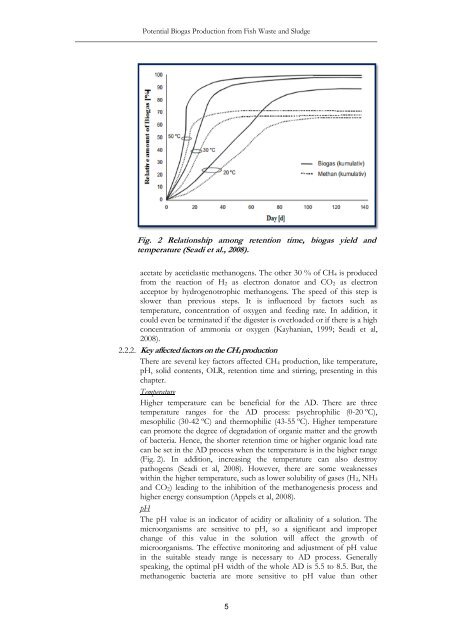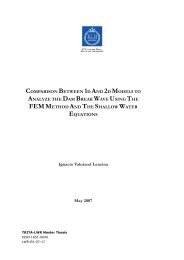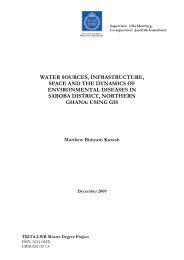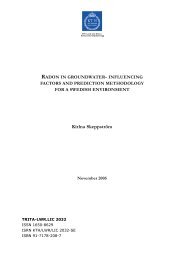POTENTIAL BIOGAS PRODUCTION FROM FISH WASTE AND ...
POTENTIAL BIOGAS PRODUCTION FROM FISH WASTE AND ...
POTENTIAL BIOGAS PRODUCTION FROM FISH WASTE AND ...
Create successful ePaper yourself
Turn your PDF publications into a flip-book with our unique Google optimized e-Paper software.
Potential Biogas Production from Fish Waste and SludgeFig. 2 Relationship among retention time, biogas yield andtemperature (Seadi et al., 2008).acetate by aceticlastic methanogens. The other 30 % of CH 4 is producedfrom the reaction of H 2 as electron donator and CO 2 as electronacceptor by hydrogenotrophic methanogens. The speed of this step isslower than previous steps. It is influenced by factors such astemperature, concentration of oxygen and feeding rate. In addition, itcould even be terminated if the digester is overloaded or if there is a highconcentration of ammonia or oxygen (Kayhanian, 1999; Seadi et al,2008).2.2.2. Key affected factors on the CH 4 productionThere are several key factors affected CH 4 production, like temperature,pH, solid contents, OLR, retention time and stirring, presenting in thischapter.TemperatureHigher temperature can be beneficial for the AD. There are threetemperature ranges for the AD process: psychrophilic (0-20 ºC ),mesophilic (30-42 ºC ) and thermophilic (43-55 ºC ). Higher temperaturecan promote the degree of degradation of organic matter and the growthof bacteria. Hence, the shorter retention time or higher organic load ratecan be set in the AD process when the temperature is in the higher range(Fig. 2). In addition, increasing the temperature can also destroypathogens (Seadi et al, 2008). However, there are some weaknesseswithin the higher temperature, such as lower solubility of gases (H 2, NH 3and CO 2) leading to the inhibition of the methanogenesis process andhigher energy consumption (Appels et al, 2008).pHThe pH value is an indicator of acidity or alkalinity of a solution. Themicroorganisms are sensitive to pH, so a significant and improperchange of this value in the solution will affect the growth ofmicroorganisms. The effective monitoring and adjustment of pH valuein the suitable steady range is necessary to AD process. Generallyspeaking, the optimal pH width of the whole AD is 5.5 to 8.5. But, themethanogenic bacteria are more sensitive to pH value than other5
















